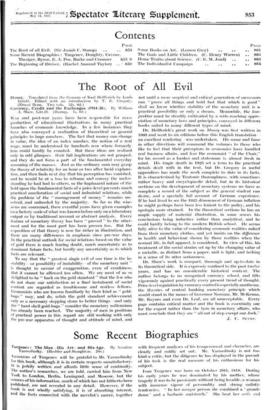The Root of All Evil Money. Translated from the Gorman
of Karl Helfferich by Louis Infield.. Edited with an introduction by T. E. Uregory. (Ernest Bonn. Two vols. 52s. 6d.) Currency, Credit and the Exchanges (1914-26). By William A. Shaw, Litt.D. (Harrill). 7s. 6d.) Wait and post-war years have been responsible fOr mass production of educational illustrations in many .practical branches of economic knowledge. In a few instances they have also conveyed 'a realization of theoretical or general piinciples to large numbers. The fact that money can change in value, the idea of an index number, the notion of a real wage, must be understood by hundreds now where formerly tens could hardly be counted. But these ideas are realized only in odd glimpses—their full implications are not grasped, and they do not form a part of the fundamental everyday reasoning of the masses. Just as the ordinary man may grasp the theory of relativity for an hour or two after lucid explana- tion, and then' finds next day that his perception has vanished, and he would be at a loss to refratne and convey the under- standing he had had to others, so the haphazard nature of the hold upon the fundamental facts of a price-level prevents Much practical amelioration of social and industrial relations, while the problein of the " management of money " remains un- solved, and unheeded by the majority. So far as the wise- acres are concerned, these eventful years have given examples on a factory scale of what was known before only on a laboratory output or by traditional account or abstract analysis. Every feature of monetary theory has been '• proved " to the utter- most and for the most -part has been proven too. But the exposition of that theory is now far richer in illustration, and there arc many differences in emphasis since pre-war days. In the practical outlook for social relations based on the value of gold there is much fearing doubt, much uncertainty as to dominant future facts, but hardly any uncertainty as to which
filets arc relevant.
To say that the " greatest single evil of our time is the in- stability--or possibility of instability—of the Monetary unit " is thought to savour of exaggeration, even of crankiness. But it cannot be affirmed too often. We are most of us so delighted to be " back on the gold standard " that the few who do not share our satisfaction as a final instalment of social content are regarded as troublesome and restless fellows. Economists who are known familiarly by their kind as " gold- bugs " may, and do, relish the gold standard achievement only as a necessary stepping stone to better things—and only the " hard shell gold-bugs " consider the monetary millennium has already been reached. The majority of men in positions of practical power in this regard are still working with only the pre-War apparatus of thought and attitude of mind, and
not until a more sceptical and critical generation of successors can " prove all things and hold fast that which is good" shall we know whether stability of the monetary unit is a practical possibility or only a dream. Meanwhile, the kon- junktur must be steadily cultivated by a wide-reaching appre- ciation of monetary laws and principles, conveyed in different books suited to ninny different types of mind.
Dr. Helfferich's great work on Money was first written in 1903 and :went to six editions before this English translation-- an excellent rendering —was undertaken. His name and fame in other directions will commend the volumes to those who like to feel that their preceptors in economics have handled real business affairs, and fear the economist " of the Chair," for his record as a banker and statesman is almost fresh in mind. His tragic death in 1923 set a term to the practical details dealt with in the text, but Dr. Gregory in useful appendices has made the work complete to date in its facts. It is characterized by Teutonic thoroughness. with sometimes rather heavy and encyclopaedic detail, but in its historical sections on the development of monetary systems we have as complete a record of the subject as the general student can desire, and a specially full account of German experience. If he had lived to sec the 1923 denouement of German inflation he might perhaps have been less lenient to the policy, and his apologia more strained. In the theoretical sections he has an ample supply of material illustration, in sonic senses his conclusions being inductive rather than analytical, and he could hardly belong to the modern British school. Ile seems fully alive to the value of considering economic realities naked from their monetary clothes, and yet insists on the difference in health and behaviour shown by those realities when the normal life, in full apparel, is considered. In view of this, his treatment of the social strains set up by the changing value of a metallic, as distinct from a paper, unit is light, and lacking in a sense of its utter seriousness.
Dr. Shaw's work is compact, thorough and up-to-date in its theoretical side. It is expressly confined to the past twelve years, and has no considerable historical context. The author belongs to no recognized currency school, and tilts vigorously against practically every present trend of thought. Price-level regulation by currency control is especially anathema, the theories of central banking monetary principle which would stand in the names of Governor Norman, Mr. McKenna, Mr. Keynes and even 1)r. Leaf, are all unacceptable. Every page contains critical matter and the book is essentially one for the expert rather than the tyro in monetary affairs, who must conclude that they are " all out of step except our Jock."
J. C. STA M


























































 Previous page
Previous page